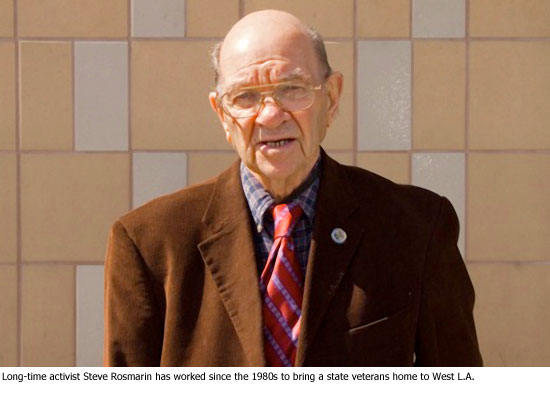A veterans residence worth waiting for
March 11, 2010
Steve Rosmarin pushed for 20 years to get a state long term care home for veterans built in West Los Angeles.
Now that it’s finally scheduled to open this summer, he’d love to be among the first to move in.
Rosmarin, a retired stockbroker and travel agent, is a very unretiring veterans’ activist. At 82, he’s twice been state commander of the Jewish War Veterans, once in the early 1960s and again in 2007-8. Since 1999, he’s served on the county’s Veterans Advisory Commission.
Not a bad achievement for a one-time private first class who served in Korea in the early days of the Cold War, hunting for Japanese holdouts and worrying about the Russians north of the 38th parallel. The slight teen carried a BAR, a Browning Automatic Rifle, a powerful weapon that weighed more than 18 pounds. “They liked to give the short guys the big weapons,” he explains.
As a veterans’ advocate, he has long pushed for advances in education, health care and housing for former military personnel in the Los Angeles area. The housing issue became important to him as he watched as veterans of World War II, Korea and, more recently, Vietnam hit retirement age, and face scarce housing options on fixed incomes.
“We have so many veterans here that are aged and in need of housing and care,” he says. “We needed to do something.”
In the late ‘80s, Rosmarin and other advocates figured the best solution was building a state veterans home in L.A, now home to about 400,000 vets. At the time, there was just one state retirement residence for vets operated by the California Department of Veterans Affairs, a large home in the Napa Valley community of Yountville – hundreds of miles away. In the ‘90s, two new state homes were built, but neither was close to Los Angeles, with its large veteran population.
He lobbied members of Congress, veterans’ officials and Sacramento lawmakers to locate a facility on the federal Veterans Affairs campus in Westwood. The area had spare land and proximity to the veterans hospital and the UCLA Medical Center. And, after all, the VA campus had started in the 1880s as the Sawtelle Veterans Home for disabled military men. Locating a facility there meant the vets could more easily stay connected to family and friends.
Their campaign got a big boost when federal Veterans Affairs officials declared California one of two states “in great need” for veterans’ housing and required new homes to be built in areas with high concentrations of veterans. The state passed bond funding between 2000 and 2004, and a building plan emerged to construct five new state homes with both state and federal funds—three of them in Los Angeles and Ventura counties.
Rosmarin’s key role was evident at the 2007 groundbreaking, when he got the call to introduce Gov. Arnold Schwarzenegger.
The 396-bed Veterans Home of California–West Los Angeles facility will open this summer. The $187- million home will include a residential care wing as well a skilled nursing facility and a “memory care unit” for vets with Alzheimer’s or dementia. Two other smaller Southern California facilities–60-unit residences in Lancaster and Ventura–also opened in recent months.
When the application period began last month for the West L.A. home, Rosmarin, who until recently had been living on his own in the San Fernando Valley, quickly put himself in the running. He wants to be closer to his two daughters and his L.A.-area roots in Sherman Oaks and West Hollywood. He moved into the new state veterans’ home in Lancaster in the past few weeks—temporarily, he hopes. Widowed three years ago, Rosmarin had wanted to wait until the West L.A. facility opened to make the move, but he had to make the jump early when his doctor recently told him that his health and medication issues meant that he should no longer be living alone.
He’s not the only one interested. More than 700 veterans have requested applications to the West L.A. facility, according to spokeswoman Jeanne Bonfilio. Veterans must be California residents, 62 or older and honorably discharged. Disabled vets can be younger. The rent covers room, board and all services. Rates vary, ranging from 55 to 70 % of a veteran’s income, depending on the level of care in the facility.
After getting a taste of living in a state home, Rosmarin is an even bigger booster, touting them as clean, well-operated alternatives to costly private sector facilities. “I’ve visited several [private facilities], and you always get the smell of hospitals and the smell of other things,” he says, speaking by phone from what he hopes will be his temporary bivouac in Lancaster. “Here it smells spotless. It’s a great thing to see.”














 405 bridge work causes a stink
405 bridge work causes a stink

